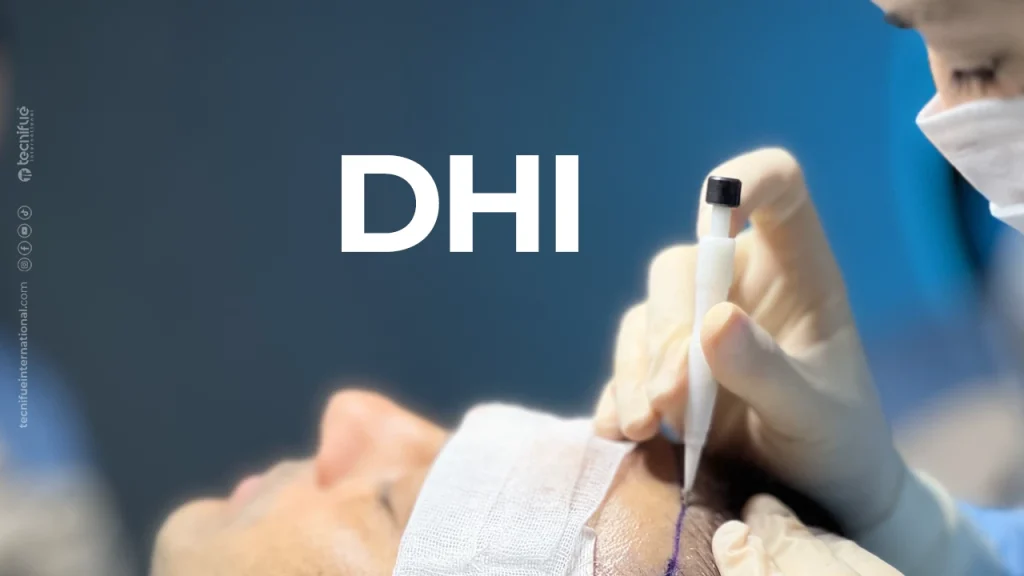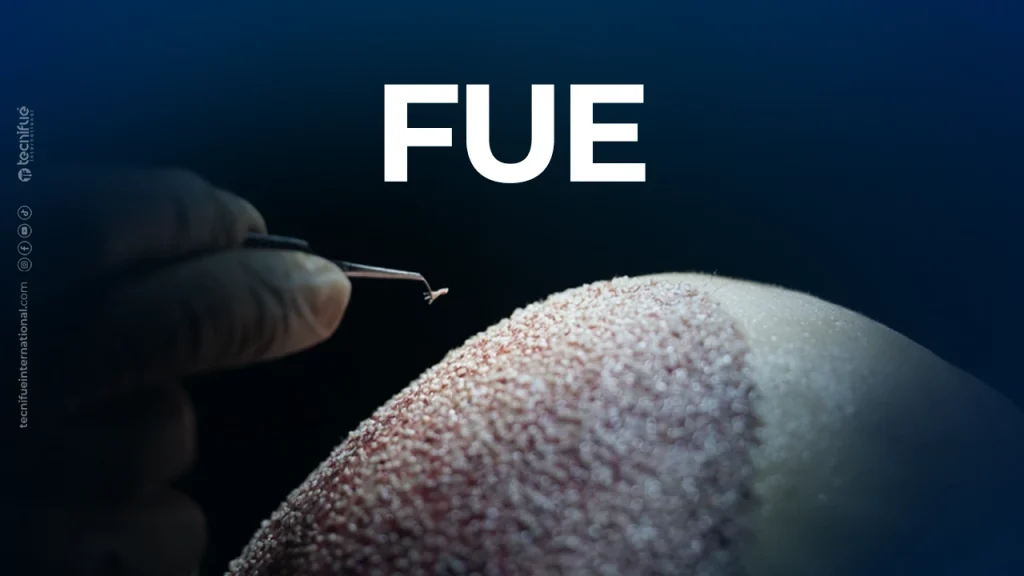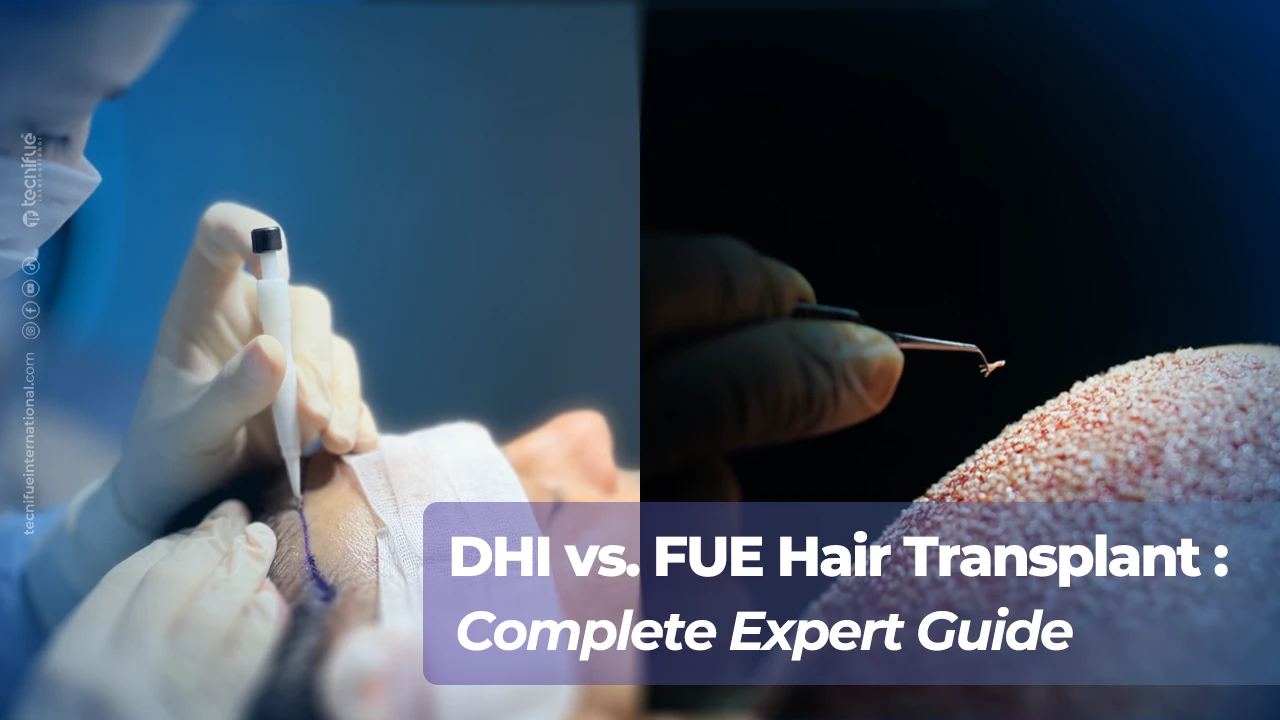If you’re thinking about a hair transplant, you’re probably wondering about the DHI vs. FUE Hair Transplant debate.
This is a hot topic in our field, and for good reason.
There’s a lot of information out there, but much of it is either biased or incomplete.
That’s why I’m writing this blog.
I want to share our clinic’s experiences and discuss key aspects, such as healing time and which method is better if you prefer not to shave your head.
I’ll also touch on less familiar topics like the risk of necrosis when comparing these methods.
By the end of this blog, you’ll have a solid understanding of the differences.
But before we jump in, let me introduce myself.
I’m James, Co-founder of Tecnifue International Hair Clinic in Istanbul, Turkey.
Since 2012, our clinic has helped patients from over 28 countries.
I consider myself an expert in this field, but I’ll let you decide that after reading my posts.
Now that you know me, let’s dive into DHI vs. FUE Hair Transplants.
Let’s get started!
Quick Refresher on DHI vs. FUE Hair Transplant

If you’ve visited our website, you probably know the differences between these two methods.
But let’s refresh your memory.
It’s easy to forget details since we cover a lot.
First, the extraction process is the same for both DHI and FUE.
There are no differences there.
For the FUE method, we open channels first and then manually implant the extracted grafts individually.
In contrast, with the DHI method, no channel opening is needed.
The grafts are placed in a Choi pen and then directly implanted into the recipient area.
That’s the simplest way to understand the difference between these methods.
Before we compare them directly, let’s look at the advantages of the DHI Hair Transplant.
What are the Advantages of a DHI Hair Transplant?
There are several advantages to the DHI Hair Transplant method.
First, it’s the best choice if you don’t want to shave your entire head.
Second, because there’s no channel opening, there’s less trauma to the scalp tissue.
This means faster healing.
Third, you’ll see significant results by the six-month mark.
These advantages are based on feedback from our patients and my personal experience.
Now, let’s tackle the big question: Which method is better, FUE or DHI?
Which is Better: DHI or FUE?
This question has many nuances. But let’s break it down systematically using a few key factors.
Think of these as Hair Transplant Key Performance Indicators (KPIs).
Side note: I might have just coined a new term in hair restoration!
I’ll cover critical aspects of hair restoration and see which method excels or if they perform similarly.
Excited?
Let’s dive in.
DHI vs. FUE Hair Transplant: Best Option for Non-Shaving
We’ve touched on this in the advantages of DHI.
When comparing DHI and FUE for non-shaving transplants, DHI is the clear winner for all types of hair loss.
Both methods offer the same solution if the treatment area is completely bald.
Both methods are equally effective for a receding hairline with no hair in the treatment zone.
However, if the hair is thinning and there’s still hair in the surrounding areas, DHI is the best option for a non-shave transplant.
So, let’s give DHI the credit it deserves and call it the winner for this performance indicator.
Extraction
As discussed before, the extraction is performed exactly the same way for both hair transplantation methods.
So there is no difference on this factor that can indicate a winner.
Lets call this one a draw.
DHI vs. FUE Hair Transplant: Risk of Graft Damage

The risk of graft damage is crucial for a successful hair transplant.
It can occur at different stages of the procedure.
Let’s break down these stages and see how each method affects graft damage.
First is the extraction process.
Since the extraction is done the same way for both DHI and FUE, the risk of graft damage is equal here.
The preservation of grafts is also identical for both methods, so there’s no difference.
Next, let’s look at preparing the graft for implantation.
With the FUE method, grafts are handled with tweezers, minimizing the risk of damage.
For the DHI method, grafts are placed in a Choi implanter, which involves a slightly higher risk of damage than FUE.
Finally, the implantation phase.
In FUE, grafts are manually implanted using special tweezers.
This stage carries a risk of graft breakage if not done correctly.
The grafts have no protection and can be damaged by direct contact with the scalp.
On the other hand, the DHI method uses a Choi Implanter, which provides a protective steel layer around the graft, reducing the risk of damage to near zero.
You might think the risks are similar, but here’s an important nuance.
Not all stages of a hair restoration procedure have the same complexity or require the same level of expertise.
The implantation phase is more complex and critical than other stages.
Since DHI offers better protection during this stage, it has a lower overall risk of graft damage.
Think of it like a mathematical equation where several inputs determine the outcome.
If all inputs have the same value, it’s easy to conclude.
However, if one input is more critical, it significantly impacts the final result.
In hair restoration, the implantation phase is that critical input, and DHI excels here.
Sorry for the detour into mathematics, but these nuances are important.
I want to ensure you have all the insights to make an informed decision.
To sum up, DHI has the least risk of graft damage.
Next, let’s focus on the healing time.
DHI vs. FUE Hair Transplant: Healing Time
We need to focus on the channel opening phase to understand the healing time for both methods.
With the FUE method, channels are opened, which causes some skin trauma.
In the DHI method, the Choi Implanter tip is also inserted into the scalp to implant the graft, causing some skin trauma.
There’s a clear difference in this aspect.
In the FUE method, a small cut is made during the channel opening.
With the DHI method, no cut is made; the graft is directly implanted with significantly less tissue damage.
Healing with the DHI method tends to be a few days faster.
You can see this difference in the pictures taken the next day after an FUE and DHI transplant.
The scab formation after a DHI transplant looks much cleaner, and the skin appears healthier compared to FUE.
So, the DHI method is the clear winner here.
Next, let’s focus on the risk of necrosis.
DHI vs. FUE Hair Transplant: Risk of Necrosis
Before diving into this topic, I want to acknowledge the sensitivity of discussing necrosis.
As an expert, my insights can impact medical specialists worldwide.
However, it’s my ethical duty to share accurate and comprehensive information, especially for medical decisions of an aesthetic nature.
It’s important to note that I haven’t found any studies comparing the risk of necrosis between DHI and FUE.
Therefore, I need more than my findings to draw a general conclusion.
More data and independent research are needed.
Technically, there is a risk of necrosis with both methods.
Based on our data from over 8,000 patients, we have had only three cases of necrosis, indicating a very low risk at our clinic.
Proper aftercare is crucial, and we have successfully managed these cases, resulting in total growth and survival of all grafts in the necrosis zone.
We haven’t had any cases of necrosis related to the DHI method at our clinic.
However, we’ve performed more FUE transplants since 2012, so the data size isn’t a perfect reference, especially given the low number of necrosis cases.
Therefore, it’s not accurate to claim that DHI has a higher or lower risk of necrosis without more data.
Necrosis can result from inadequate follow-up, not necessarily the method or quality of the medical team.
Often, there’s too little data to determine the exact cause of necrosis.
So, until we have more data, let’s call this a draw.
Next, let’s discuss the time it takes to see the final results when comparing DHI with FUE.
DHI vs. FUE Hair Transplant: Time Needed for Full Results
Based on our experience, we can clearly identify a winner here.
But there’s an important nuance to consider.
DHI hair transplants show total hair growth in the frontal zone and midsection in about six to eight months.
FUE transplants take up to 12 months to achieve similar results.
So, for the frontal and mid zones, DHI offers quicker results.
However, the crown is a different story.
Both methods show the same slow progression of hair growth in the crown area.
The crown is a challenging zone that requires a lot of time.
Overall, DHI is the winner for quicker frontal and mid-zone results.
DHI vs. FUE Hair Transplant: Natural-Looking Results
This might be one of the most debated topics in the discussion on DHI vs. FUE hair transplant.
Both sides claim to offer more natural-looking results.
But who’s right?
Here’s my take: neither method inherently results in more natural results.
A perfectly done DHI will look better than a mediocre FUE, and a perfectly executed FUE will look better than a mediocre DHI.
It all comes down to the skill of the medical expert performing the procedure.
If both methods are performed flawlessly by experts of the same caliber, the results will be equally natural.
So, in this case, it’s a draw.
There is no clear winner here.
Conclusion: DHI vs. FUE Hair Transplants
Choosing between DHI and FUE hair transplants is complex and nuanced.
To help you decide, I broke it down systematically using a few key factors or Hair Transplant Key Performance Indicators (KPIs).
Here’s a quick summary of what we’ve covered.
Non-shaving options.
When it comes to non-shaving transplants, DHI is the clear winner.
It’s effective for all types of hair loss, particularly if the hair is thinning and you don’t want to shave your head.
Both methods are identical in extraction, so there’s no winner here.
The risk of graft damage.
Both methods have equal risks during extraction and preservation.
However, during implantation, DHI offers better protection, reducing the risk of damage.
This makes DHI the safer choice for graft integrity.
Healing time.
DHI involves less tissue damage since it doesn’t require channel opening, leading to faster healing.
This is visible in post-transplant pictures, where DHI produces cleaner scab formation and healthier-looking skin.
The risk of necrosis.
Based on our data, both methods have very low risks, but due to the small number of cases, it’s hard to draw definitive conclusions.
Until more data is available, it’s best to consider this aspect a draw.
The time it takes for final results.
DHI shows quicker outcomes for the frontal and midsection areas, typically within six to eight months.
FUE can take up to 12 months for similar results.
However, both methods show similar slow progress in the crown area. Overall, DHI is faster for most areas.
Natural Looking Results
Finally, natural-looking results depend more on the skill of the medical expert than the method.
A perfectly executed DHI or FUE will look equally natural. Therefore, this aspect is also a draw.
In conclusion, both DHI and FUE have their strengths and nuances.
Your choice should depend on your specific needs and the clinic’s expertise.
I hope this guide helped you to make an informed decision.
Need help in your Hair Transplant Journey?
As someone who has undergone a hair transplant and guided thousands over nearly 15 years, I know how challenging this decision can be.
Debates like DHI vs. FUE Hair Transplant are just a few of the many questions we tackle daily.
While the internet has democratized access to information, it has also led to the proliferation of paid PR.
This can mislead audiences, as influencers and colleagues may prioritize paid content over thorough research, making reliable information more crucial than ever.
It is crucial to get guidance from true medical consultants who can offer accurate information tailored to your case and options.
You deserve easy access to reliable information, which we aim to provide.
Our content is detailed and transparent, and our medical consultants are trained by our expert medical team to ensure they understand the intricacies of hair restoration.
If you need support on your hair restoration journey, contact us.
We offer a complimentary consultation to answer all your questions and empower you to make the decision that best suits your needs and desires.
Feel free to contact us if you have any questions about FUE vs. DHI Hair Transplant. We’re here to help.
FAQ
Is FUE or DHI better?
DHI usually has some advantages over FUE, but the best method depends on your personal situation and hair loss pattern.
What are the disadvantages of DHI?
DHI is often one of the most expensive hair restoration methods.
It’s also not widely available worldwide.
Does DHI transplant heal faster?
DHI heals faster because it doesn’t require channel opening like FUE, causing less tissue damage and a shorter healing time.
